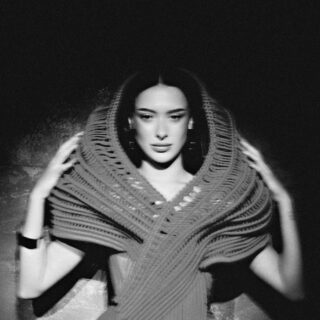words + digital illustration. Laura Knoops
issue 4 – in motion
In this digital age, boundaries blur, and distinctions fade. The once-solid lines that delineated our physical existence are replaced by ethereal networks that traverse time and space. We find ourselves in a world where the tangible and intangible converge, where the digital realm becomes an extension of our being.
But what does it mean to exist in this digital motion? Is our essence confined to our physical bodies, or do we transcend into the digital ether, existing simultaneously in both realms? As our online identities intertwine with our offline lives, the boundaries between the virtual and the real become ever more elusive. We navigate a delicate dance between authenticity and artifice, grappling with the complexities of selfhood in this interconnected web.
Yet, as we embrace this digital evolution, trust emerges as a cornerstone of our experience. In the vast expanse of digital spaces, trust is not simply bestowed upon the familiar face or the familiar touch. It must be forged through mechanisms of transparency, encryption, and decentralized consensus. Trust in the digital realm becomes a collective endeavor, where algorithms and protocols guide our interactions, ensuring the integrity and security of our transactions, communications, and shared knowledge.
In this dance of trust and transparency, the concept of the DAO emerges as a beacon of possibility. Decentralized Autonomous Organizations, powered by blockchain technology, embody a vision where trust is no longer vested in singular institutions or authorities. Instead, it flows through the veins of a distributed network, governed by consensus and executed by smart contracts.
The DAO is a testament to our collective desire to reshape the nature of organizations and governance. It heralds a paradigm where power is distributed, decisions are made through participatory processes, and transparency is not a mere buzzword but an inherent characteristic. It is a testament to our yearning for a more inclusive, equitable, and accountable world.
However, as we embrace the DAO and its promises, we must tread carefully, mindful of the complexities that arise. As lines blur and boundaries fade, we must grapple with the implications of our digital existence. We must confront questions of privacy, autonomy, and the preservation of individual agency. We must navigate the tension between the power of decentralized networks and the potential for concentration of influence and control.
In this digital motion, we find ourselves on the precipice of a new era. It is an era where our notions of self, reality, and trust intertwine in a tapestry of boundless potential. The journey ahead will require us to navigate the philosophical depths of this digital landscape, to forge a new understanding of our place within it.
As we embark on this journey, let us embrace the opportunities that digital motion affords us. Let us strive for a world where trust is not a fragile commodity but a resilient force woven into the very fabric of our interconnected existence. And may we approach the DAO not merely as a technological marvel but as a catalyst for profound societal transformation, redefining our relationship with power, governance, and the essence of being in this digital tapestry of life.
Trust in the digital realm is a crucial aspect of our increasingly interconnected and technology-driven world. As we rely more on digital platforms, transactions, and interactions, establishing trust becomes essential to ensure security, reliability, and transparency. Trust in digital systems involves confidence in the integrity, privacy, and authenticity of data and the entities involved.
A DAO can play a significant role in enhancing trust in digital systems.
Here’s why we need DAOs and how they contribute to trust:
Decentralization.
DAOs operate on decentralized blockchain platforms, reducing the need for reliance on central authorities or intermediaries. This decentralized nature promotes trust by eliminating single points of failure, reducing the risk of censorship or manipulation, and fostering transparency and accountability.
Transparency and Auditability.
DAOs utilize public blockchains, where transactions and decisions are recorded and accessible to all participants. This transparency allows for independent verification, auditability, and visibility into the organization’s operations. Participants can trust that the DAO’s actions are recorded and executed as agreed upon in the smart contracts.
Trustless Transactions.
DAOs enable trustless transactions, meaning that participants can engage in transactions and interactions without having to trust each other explicitly. Smart contracts enforce the agreed-upon rules and conditions, eliminating the need for intermediaries and reducing the risk of fraud or manipulation.
Immutable Records.
Transactions and decisions within DAOs are recorded on the blockchain, creating an immutable and tamper-resistant record. This feature ensures that once a transaction is executed, it cannot be altered or erased, providing a high degree of trust in the integrity of the data.
Inclusive Decision-Making.
DAOs allow for inclusive decision-making by involving all participants in the governance process. This inclusivity fosters trust and reduces the concentration of power in the hands of a few individuals or entities. Participants have a say in the organization’s operations, making the decision-making process more transparent, accountable, and representative.
Token Economy.
Many DAOs utilize tokens as a means of participation, governance, and value exchange. Tokens provide a clear representation of ownership or voting power, facilitating trust and transparency in the distribution of rewards and incentives within the DAO’s ecosystem.
Overall, DAOs address trust in digital systems by leveraging blockchain technology, decentralization, transparency, and inclusive governance. By removing intermediaries, reducing reliance on trust between individuals, and providing verifiable records, DAOs have the potential to enhance trust in various domains, such as finance, governance, supply chains, and more.
words + digital illustration. Laura Knoops
© Schön! Switzerland. All rights reserved.






